Ask Health: Should I Hit My Protein Goal Every Day?
One of our editors tried hitting her daily protein goal for 30 days. Here's what she learned.
Medically reviewed by Kayla Girgen, RD
The recommended amount of protein per day is about 0.36 grams of protein per pound of body weight. However, most adults don't eat nearly enough.
Protein is important for muscle growth, immune health, and hormone signaling.
I tried eating 120 grams of protein every day for 30 days to see if it could improve my energy levels, satiety, and mood.
Increasing my protein intake did improve my mood, lessened my hunger cues, and helped me feel stronger in my workouts, but I did find a few drawbacks.
Nowadays the prevailing message seems to be that we could all use more protein in our diets. Want to lose weight? Add more protein. Want to feel stronger and build muscle? More protein. Want to stay full? More protein (and fiber).
Protein is one of the three main nutrients your body needs for energy. Protein is made up of different amino acids, your body's building blocks for critical functions like muscle growth, immune health, and hormonal signaling. Protein also plays an important role in weight management by helping to reduce hunger cravings and promote the feeling of being full.
Despite how critical this nutrient is, most people don't eat enough of it. The recommended dietary allowance (RDA) of protein for healthy adults who partake in minimal physical activity is 0.36 grams of protein per pound (lbs) of body weight per day. That means someone who weighs 150 pounds, should eat approximately 54 grams of protein every day. However, research suggests most people don't eat enough of the good stuff. A study of more than 11,000 adults ages 50 and older, found that 46% did not meet their daily protein intake.
As a senior editor here at Health, I hear about protein a lot. So much so, that I began to wonder whether I was eating enough. I scheduled an appointment with a nutritionist before I started this experiment, and to no one’s surprise, we determined I probably wasn't getting enough protein.
Since I’d already gotten the OK from a licensed professional to add more protein to my diet, I decided to challenge myself to hit my daily protein goal for 30 days. Though I struggled to hit my goal at times, I found the intentionality of prioritizing protein far more helpful and important than the number of grams I was trying to reach.
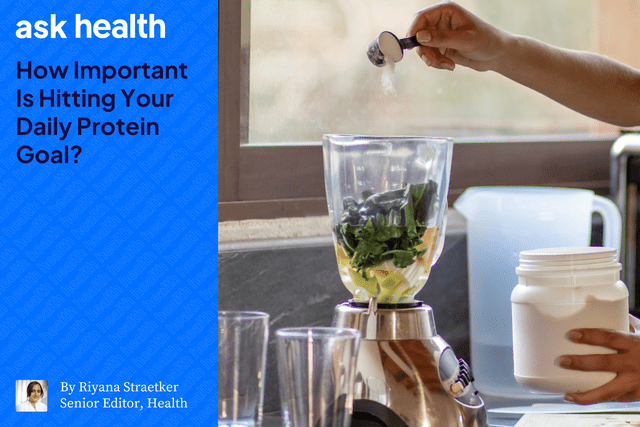
Health/Getty/MarsBars
Before You Get Started
First, I decided I needed to track what I ate. A very important caveat here is that tracking food consumption or calories can be incredibly triggering for folks living with eating disorders or a history of disordered eating.
If you feel triggered or destabilized by tracking what you eat, I strongly encourage you to skip this step. Eating is first and foremost about powering your body, not about numbers in a log. There are other ways to eat more protein rather than tracking macros (more on that below).
Nutritional goals look different for everyone. Your health conditions, activity levels, and body composition all play a role in what and how much you should be eating. If you’re unsure where to start, working with a healthcare professional like a registered dietitian is a great first step.
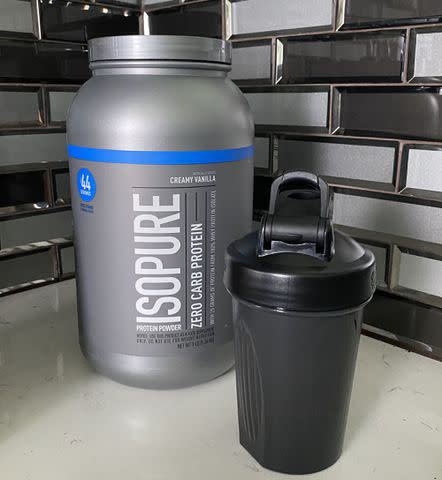
Riyana Straetker
Setting a Protein Goal
Before I could reasonably say I was “eating more protein,” I decided to track my protein intake for a few days without changing my diet. That way, I’d have a baseline of what I could do without trying and could better establish a goal to aim for.
My daily diet is pretty consistent—meal-prepped eggs or free yogurt from the office for breakfast, a Factor meal for lunch, and either takeout or simple whatever-I-can-throw-together meals for dinner. Usually, I’ll snack on fruit, a granola bar, or the occasional bag of chips (salt and vinegar is my go-to) if I’m feeling peckish between meals. And I’m a big fan of a little something sweet at the end of the day, so I’ll almost always have a popsicle or mini ice cream bar as I’m winding down for the evening.
After keeping tabs on my macros for a few days, I found I landed at roughly 80-85 grams of protein a day without trying. Not bad, but I knew I could do better. To calculate the exact macros I would need based on my body weight and activity level, I used an online calculator (math has never been my strong suit). If you'd like to get a rough idea of how much protein you should be eating, simply multiply your body weight in pounds by 0.36. That will give you the amount of protein you need, at minimum, in grams. If you're more mathematically inclined than I am, that looks like:
Body weight in lbs x 0.36 = daily protein in grams.
After doing the calculations, and adjusting for my activity level, I settled on 120 grams of protein per day as my ideal protein goal.
Macronutrients
Often shortened to macros, these are the major nutrients you consume every day. There are three kinds: proteins, carbohydrates, and fats. These nutrients are required for growth and healthy bodily function.
I planned to track what I ate every day for the duration of the experiment to see how much protein I was getting, and how it correlated with my mood, satiety, and energy levels.
My Experience: Eating More Protein
I knew the key to this experiment would be setting myself up for success, so I grabbed a few protein-rich snacks to have on hand, including protein bars, almonds, and beef jerky sticks. I wanted to prioritize as much whole-food protein as I could, but I knew I’d need to supplement with protein powder, so I made sure I was stocked up on that as well.
My plan was simple: Pack in the protein in the places where I had the most flexibility—breakfast, dinner, and snacks. Since I work from the office three days a week and am generally a busy gal, I prefer quick and easy lunches. I wasn’t willing to give up my grab and heat Factor meals, but luckily they’re pretty nutrient-dense. For everything else, I figured I’d find ways to up the protein ante. It seemed doable as I planned it all out, but in practice, it turned out to be more difficult than I anticipated.
Breakfasts
My normal breakfasts skimped on protein, so I knew I’d need to step it up here in order to make a real impact on my daily intake. I alternated mostly between two high-protein breakfast meals: overnight oats and egg cups.
I cobbled together an oats recipe that came to about 15 grams of protein thanks to a whole banana, rolled oats, almond milk, and two tablespoons of peanut butter. I’d throw everything together in a mason jar the night before, then grab it from the fridge on my way out the door.
To keep things interesting, I’d swap out the toppings. Some days I added mini chocolate chips, other days I tossed in strawberries and sliced almonds (which added to the protein density). Since the base was so simple, really any flavor combo did the trick, so long as it played well with peanut butter. Flavors like cinnamon, apple, chocolate, and berry were my favorite, but you could truly mix in the add-ins you prefer.
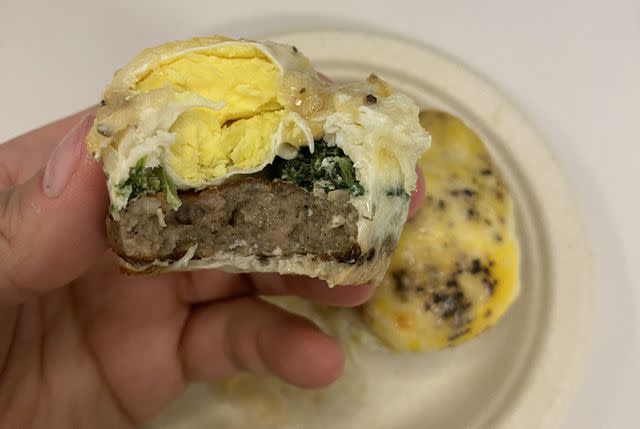
Riyana Straetker
The egg cups required a bit more prep, but it was still pretty low effort. In essence, each cup had an egg, some kind of vegetable, meat, and cheese. I’d mix up the combos to keep myself from getting bored. Some had spinach, others kale, and I’d alternate between turkey bacon and breakfast sausage. Each cup came to around 8 grams of protein, and I’d eat three for breakfast, bringing my total to 23 grams of protein.
Now, of course, I didn’t eat these every day. I live in New York City, and bagels are indisputably one of the best parts of living here. So, I wasn’t giving that up for 30 days. On days I wanted a heartier breakfast, I’d whip up an egg-veggie scramble or wrap instead. As with anything, it’s all about balance. If my breakfast was a little light on protein, I made sure to choose high-protein snacks or add in a protein shake during the day. I did find, however, that frontloading protein into my day was the best way to hit my goals.
Related: What Is Protein Powder?
Dinners
I’m a lazy girl when it comes to dinner, so I knew I’d need to find low-lift ways to add protein to my end-of-day meals. The key to my success turned out to be playing with portions.
I live alone, so I’m often just cooking for myself, which means I’m reluctant to spend a lot of time over the stove making some elaborate six-serving meal I’ll be eating for days on end. Instead, I think of my meals in terms of components: a protein, a carb, and a fiber. I don’t usually pay too close attention to serving size—as long as it looks balanced, it works for me.
With this experiment, I made sure to have proportionally more protein on my plate and to eat it first. So for example, when I made my normal sauteed shrimp, rice, and mixed veggies, I added a half serving of shrimp and used a smaller scoop of rice, or skipped the rice altogether. This way, I would get at least 20 grams of protein into dinner. Some nights, I was able to get up to 35 grams.
This method worked for eating out, too. I’d make sure whatever I ordered had a protein, and I’d focus on eating it first to make sure I was meeting my goal.
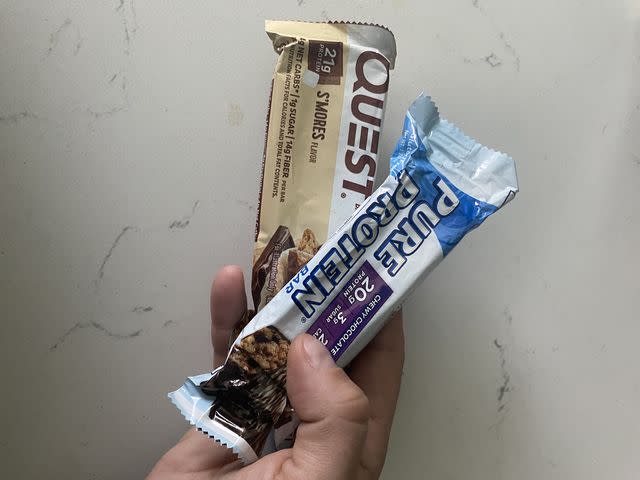
Riyana Straetker
Snacks
Where I really made up ground on my protein intake was through snacks. I prioritized protein-dense options. I had my fair share of protein shakes and protein bars, but I also mixed in easy grab-and-go options. For me, that looked like a lot of beef jerky, almonds, cheese sticks, and yogurt. I also experimented with new-to-me snacks, like dried edamame or high-protein waffles with peanut butter.
I often packed packaged snacks that I could easily bring to work so that the free office snacks wouldn't tempt me. I won’t pretend like I didn’t occasionally grab a bag of salt and vinegar chips, but I always tried to include one protein-forward element. It made for some weird combinations—I can’t say I recommend chips and yogurt as a tasty option—but it did help keep me on track.
I even tried swapping in high-protein options for my nightly sweet treat. A particular favorite was mixing a scoop of protein powder into vanilla Greek yogurt. It tastes just like pudding and adapted well to any topping I could think of. Was it as satisfying as ice cream? No, because ice cream feeds my soul. But it did help me hit my goals the times when I didn’t eat as much protein during the day.
Because I was working hard to meet my goal of 120 grams of protein per day, I had multiple snacks most days. Depending on the mix, I’d get an additional 20 to 50 grams throughout the day.
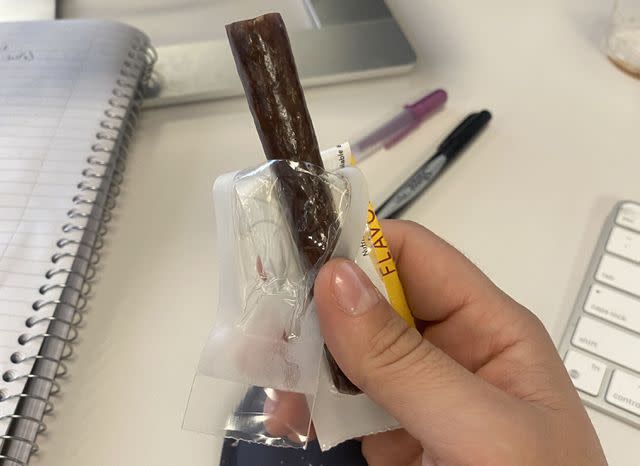
Riyana Straetker
Results: Did Eating More Protein Improve My Health?
Ultimately, yes. I felt much more satiated throughout the day than I did before. I also felt stronger during my workouts and much more emotionally stable during the day—no “sugar crashes” or “hanger” here. I was also pleasantly surprised to find that I was less prone to late-night snacking when I’d eaten enough protein during the day.
The downside of all that protein is that I wound up with quite a few stomach aches throughout my experience. I knew that indigestion and bloating could be side effects of eating a lot of protein, but that knowledge didn't make the experience less uncomfortable.
Where I most struggled during my 30 days was finding ways to make protein exciting. It can feel a bit tedious to keep up with your exact macros, particularly if you’ve experienced disordered eating habits. While it was sustainable for a month, I don’t know how long I'd be able to maintain that intense level of tracking.
Challenges
As with any dietary change, one of the largest challenges was consistency. I prefer variety in my diet, and that was pretty hard to maintain while closely counting my macros. I don’t foresee myself reaching for a package of almonds for quite some time.
This is also a dense diet to follow. Protein really fills you up, so I struggled almost daily to reach the goal I set for myself. Most days I landed somewhere between 90 and 100 grams, not 120 grams. This was mostly because I felt far too full to try eating anything else.
If you’re like me and don’t see yourself enjoying such a strict eating plan, I’d try instead to prioritize protein rather than counting it. For example:
Eat protein at every meal, including breakfast and snacks.
Swap low-protein foods for high-protein foods (like regular yogurt for Greek yogurt).
Don’t shy away from protein powder or shakes—they’re easy and pack a huge punch.
Have high-protein snacks readily available so low-protein options are less tempting.
Related: Can You Eat Too Much Protein?
Final Verdict
What I’ll take away from this experience is that protein is valuable—I felt stronger and more capable during my workouts, less crabby during the day, and much more satisfied after my meals. But there is such a thing as too much of a good thing, at least for me there was. There is no such thing as a “one size fits all” diet, and this is no different.
Going forward, I’ll continue to think about protein first, but since I’m not a bodybuilder, I have no plans to be strict about my protein intake. Instead, I’ll do my best to eat things that are nutritious and satisfying—without overeating for the sake of hitting a “number.”
Riyana Straetker is a senior editor at Health. A longtime gym rat and veteran health editor, she wanted to see just how much of a difference protein can make. She increased her daily protein intake by 40g to see if eating more protein would make a difference in her overall health.
For more Health.com news, make sure to sign up for our newsletter!
Read the original article on Health.com.

